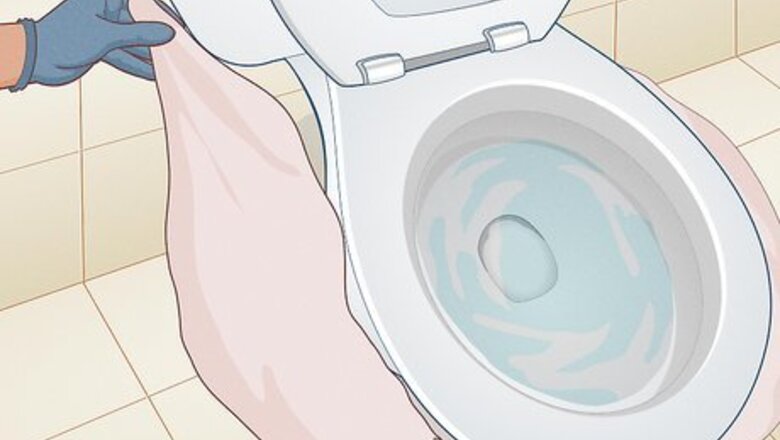
views
- Place the snake into the toilet so that the curved section of the tubing leads down through the toilet drain and up into the plumbing.
- Firmly push the handle of the snake downward toward the toilet while rotating the handle clockwise until the snake is fully extended or hits the blockage.
- Rotate the handle counterclockwise a few times to dislodge the blockage, then, while still rotating it, pull the handle to retract the snake and remove the clog.
Using the Snake
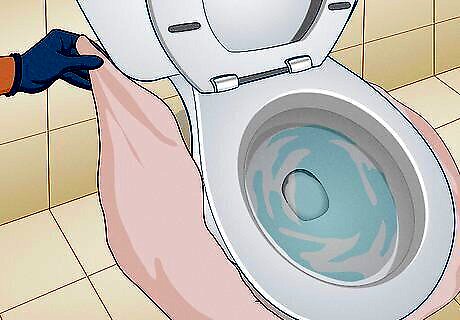
Cover the floor around the toilet and wear rubber gloves. Lay down a couple of old towels or rags to protect the floor—something you don’t mind getting dirty. It’s possible that water may splash out of the toilet bowl as the snake works on the clog, and if the clog is caused by waste, it’s best to protect your floors. For the same reason, throw on a pair of rubber gloves to keep your hands clean. Also, keep a bucket or a trash bag handy to collect any debris the snake retrieves. To be extra cautious, turn off the water to the toilet by turning the knob behind the toilet clockwise, or close the flapper inside the tank to keep the water from overflowing if you've just discovered the clog. Wash the towels in a laundry machine with about 0.5 cups (120 mL) of color-safe bleach immediately after you’re finished and wipe down the floor beneath with a disinfecting solution.
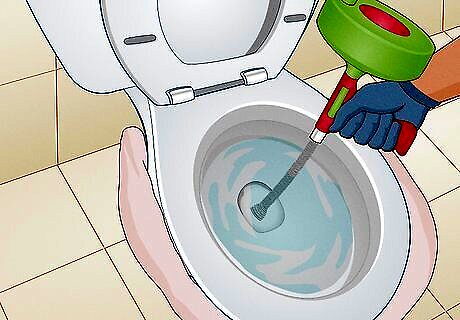
Place the end of the snake into the toilet. Pull the handle of the toilet snake back toward you so that the snake retracts through the plastic or metal rod, until only the end of the snake is visible at the end of the rod. Then rest the curved section of the rod at the bottom of the bowl, where the bowl narrows into a pipe. Orient it so that it curves upward, into the initial, upward section of your toilet’s plumbing. The plastic or metal rod or tubing around the snake prevents the snake itself from scratching the porcelain. If everything is properly inserted, you won’t be able to actually see the end of the snake; it’ll be hidden from view inside the toilet.

Push down on and rotate the handle to fully extend the snake. Gently but firmly push the handle at the end of the snake downward, pushing the snake itself through the metal rod and into the toilet’s plumbing. As you do, rotate the handle clockwise to help the snake find its way through the plumbing. Since the plumbing of your toilet is curved, and the snake is fairly rigid, it may take a little effort to feed it all the way in. Work slowly and patiently until the snake can’t go any further. If your snake is making progress into the plumbing, you’ll be able to push the handle down. Once the snake has reached the obstruction, you’ll have greater difficulty pushing the handle.
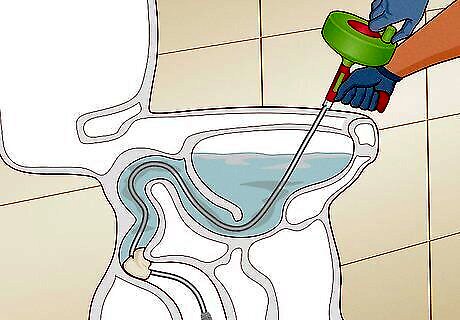
Fully extend the snake past the obstruction, then turn the handle. Continue to push and turn the handle of the snake until the handle reaches the metal tube, meaning the snake is fully extended. Then, turn the handle clockwise 5-10 times, then 5-10 times in the other direction to loosen the obstruction. If you notice the snake slowing down or coming to a stop, it may have encountered the obstruction. Gently jostle the shaft slightly and keep turning the handle to help the snake travel past the object. Your snake is about 3 feet (0.91 m) long, and your toilet plumbing is about 2.5 feet (0.76 m) long, meaning the snake, when fully extended, spans the entire length of the plumbing, helping to clear the clog.
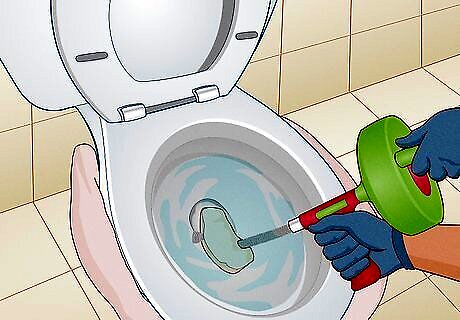
Pull and twist the handle to retract the snake. Pull the handle while rotating it counterclockwise to retract the snake from the plumbing. Once you can’t pull any more, lift the metal tube out of the bowl. If the obstruction was caused by hair, keys, or other small objects, the snake will most likely pull these out with it. Dispose of any organic matter in the garbage, or disinfect small objects with a sanitizing wipe or disinfecting spray. If the snake clears the clog, the water in the bowl will drain. If it hasn’t drained, snake the toilet again until it does, then flush the toilet after retracting the snake to ensure the clog is cleared. Wash the snake with warm water and dish soap to disinfect it after each use.
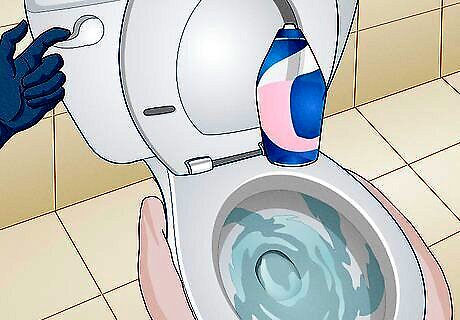
Plunge and flush the pipes with toilet cleaner. Once the job is finished, use a plunger on the toilet a few times to get rid of any remnants of the clog. Then, pour about 0.5 cups (120 mL) of toilet bowl cleaner into the toilet and let it sit for 30 minutes.. Then flush the cleaner down the toilet. The chemicals in toilet cleaning solutions are often potent enough to dissolve and whisk away whatever residual debris remains in the pipes. Only use cleaners that are intended for toilets. Regular drain cleaners like Drano can eat through galvanized plumbing pipes and wreak havoc on septic systems. Alternatively, pour about 1 cup (240 mL) of baking soda and 2 cups (470 mL) cups of white vinegar into the bowl (gradually, so that the mixture doesn't bubble over into the floor), wait 10 minutes, then flush.
Preventing Future Clogs

Only place water-soluble items into the toilet. Before putting anything in the toilet, make sure that it’s meant to be there. The list of things it’s okay to flush down the commode is pretty short; in most cases, human waste and toilet paper only. Never try to get rid of paper towels, tissues, makeup pads, tampons, condoms, cardboard, hair, or any other materials that aren’t easily dissolved by flushing them. Toys are a leading culprit of clogs in households with small children. If you have kids, keep the door to your bathroom shut and make sure they know that it’s not a good place to play. Keep a small garbage can with a lid next to the toilet so you or guests can throw away non-flushables. If you’re not sure whether or not a certain item is safe to flush down the toilet, chances are it isn’t.
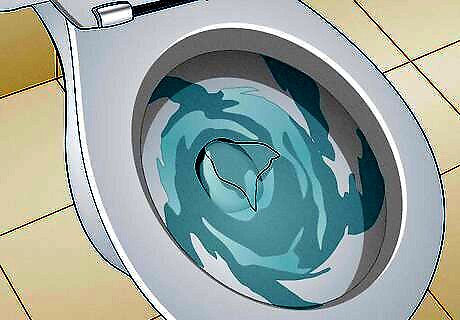
Reduce the amount of toilet paper you use. Though toilet paper is water soluble, trying to flush too much at once can still cause clogs. Try to use less toilet paper, or flush the toilet more often, like after every 1-2 uses of toilet paper. Also, while wet wipes are often advertised as flushable, they tend to clog pipes anyway. If possible, use toilet paper instead, or only flush 1-2 wipes at a time. If you have multiple bathrooms in your home, try using a different one from time to time so that one toilet’s plumbing isn’t constantly getting overworked. If you often find yourself with clogs, consider switching to single-ply toilet paper. It may not be as comfortable or absorbing, but it breaks down much faster after it’s flushed. If there’s a lot of toilet paper in the bowl, hold half of the toilet paper back with a plunger when you flush. Flush again once it is finished.
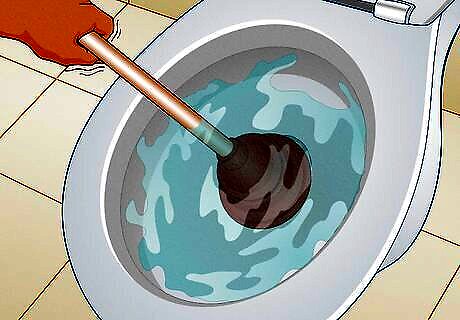
Address clogs as soon as you notice them. The best way to prevent a nasty clog is to act as soon as you suspect one might be building up. If the water level in your toilet seems low, or it has trouble flushing or refills slowly, there may be an obstruction throttling the water flow somewhere. In addition, a gurgling toilet may indicate a partial clog. If you notice any of these signs, don’t flush just yet–use a plunger to dislodge clogs before they get bad enough that you have to break out the snake. Look for bubbles in the water in the toilet bowl and keep an ear out for rattling in the pipes. These could also be signs of blockage. Reserve snakes for stubborn clogs. Plunging, cleaning and not putting anything in the toilet that doesn’t belong there are your first defenses. If you’re careful, you’ll rarely find yourself in a situation that requires the use of a snake.

Keep the toilet and pipes clean. Make sure to clean your toilet, and clean your toilet reservoir, at least once or twice a month, or ideally, once a week. This helps your toilet stay ship-shape, and makes unclogging it a bit easier without a layer of grime getting in the way. Use cleaners specifically formulated for use in toilets and pay attention to any signs that suggest a clog might be forming. Use a toilet brush to scrub the water jets around the rim of your toilet, which help propel water and waste down the pipes, preventing clogs.
Other Ways to Unclog a Toilet
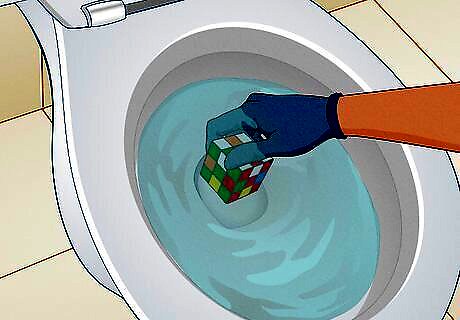
Remove objects from the pipe with rubber gloves. If the clog is caused by a children’s toy or another everyday object sitting at the mouth of the toilet drain, your hands will be enough. Throw on some rubber gloves, reach into the bowl, and pull the object out. If you can’t quite reach it, use an unspooled wire clothes hanger or any other sort of hook to fish it out.
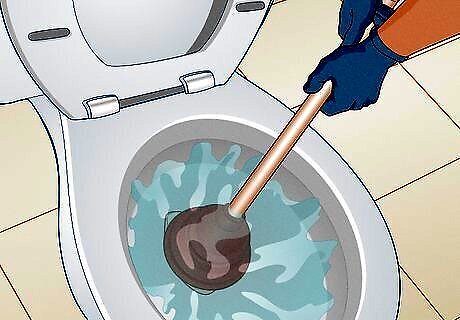
Clear most clogs using a toilet plunger. Before you reach for the snake, try to unclog your toilet with a plunger. Place the rubber head of the plunger directly over the drain of the toilet bow. Then, gripping the plunger’s handle with 2 hands, vigorously work the plunger up and down, pushing and pulling on the handle for about 20-30 seconds, then remove the plunger. If the clog cleared, the water in the bowl will drain. If not, continue to use the plunger until it does. In order to plunge effectively, there needs to be a bit of water in the bowl. If there isn’t, pour 3–4 cups (710–950 mL) of water directly into the bowl, then get plunging.
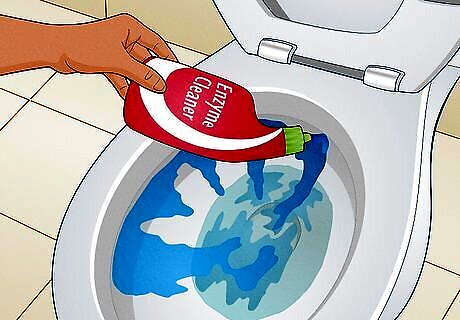
Break down clogs with an enzyme cleaner. An enzyme cleaner uses a mixture of chemicals and bacteria to dissolve organic matter stuck in your toilet’s plumbing. Simply pour about 1 cup (240 mL) of cleaner directly into the toilet bowl (or the amount suggested on the product’s packaging), then give it a few hours to do its thing. Ideally, let it sit for 24 hours hours before flushing the toilet. If it’s the only toilet in the house, and you can’t wait 24 hours, give it as much time as you can afford, or ask to use the neighbor’s bathroom in the meantime. Repeat this process a few times each month, regardless of whether or not the toilet is currently clogged, to keep the plumbing free of debris and help prevent future clogs.
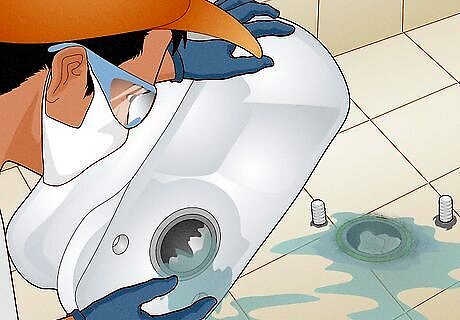
Call a plumber to have a clog cleared professionally. When all else fails, it’s time to call someone with the equipment you might not have at home. A plumber is able to diagnose the problem and use a variety of tools to fix it, or tell you the best way forward. If the clog is severe, the plumber may need to remove the toilet, or you may have to have some work done on your pipes, but that’s better than letting the problem sit until it’s more than just your pipes that need fixing.




















Comments
0 comment